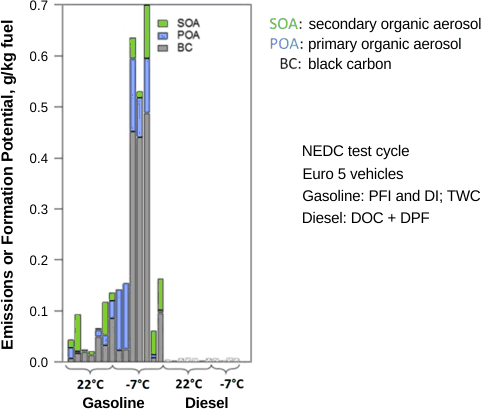Study: Modern gasoline cars produce more carbonaceous PM than diesel cars
26 July 2017
A major emission study led by the Laboratory of Atmospheric Chemistry at the Paul Scherrer Institute (PSI), Switzerland, has found that modern gasoline cars emit much more carcinogenic particulate matter—including black carbon (BC) and primary organic aerosol (POA)—than modern diesel cars. The study results, published online in Scientific Reports by the journal Nature, also show that gasoline cars emit more volatile organic compounds (VOC) that form far more toxic secondary organic aerosol (SOA) compared to modern diesels.
The research was conducted based on a collaboration agreement between the Swiss Federal Office for the Environment and the European Commission—Joint Research Centre in Ispra, Italy (JRC), with the participation of the Aix Marseille University, France; NOAA Earth System Research Laboratory, Boulder, USA; CIRES, University of Colorado, Boulder, USA; University of Montreal, Canada; and the Carnegie Mellon University, Pittsburgh, USA.
The gasoline cars emitted on average 10 times more carbonaceous aerosol at 22°C and 62 times more at −7°C compared to diesel cars, mainly due to substantially higher BC, with emission factors at −7°C comparable to those from old, uncontrolled diesels. Low temperatures dramatically increased primary emissions and secondary carbonaceous aerosol formation from the gasoline cars but not from diesel. Strikingly, in one gasoline car, BC emissions were at least 400 times higher than those from the diesels (comparing to the detection limit).

The only primary emission that was higher in diesels than in the gasoline cars was NOx—the diesel cars emitted 10 times more NOx at both temperatures.
If SOA were to be added to the primary emissions, the inventory values for the gasoline cars would be exceeded by far, according to the study results. Emissions from modern gasoline cars (both EU and US) produced up to 6.5 times more SOA than POA after 5–10 hours of atmospheric aging. Meanwhile, the modern diesel cars produced no detectable SOA, in contrast to old diesels, for which SOA production is about equal to emitted POA.
Seventeen Euro 5 vehicles were tested in the study, including 11 gasoline and 6 diesel cars. The gasoline vehicles were a mix of PFI and DI technology and were all equipped with three way catalysts (TWC). Their odometer reading ranged from 35 to 42,146 km. All diesel vehicles were equipped with DOC+DPF (diesel oxidation catalyst and diesel particulate filter) aftertreatment and their odometer reading ranged between 1,058 and 27,410 km.
Emissions were measured over the NEDC test cycle. The emission and formation of carbonaceous aerosol was quantified through a methodology involving a combination of a bottom-up approach—laboratory measurement of tailpipe emissions—with a top-down source apportionment investigation. Further, laboratory smog chamber measurements of gasoline car SOA formation was conducted at low temperatures (−7°C), in addition to measurements at 22°C. The measurements and model indicated that downwind of Los Angeles, gasoline cars emissions lead to more secondary organic aerosol than diesel cars.
The authors of the study suggest that the absence of SOAs from the DPF-diesels is explained by the chemical composition of the THC emissions; while emissions from non-DPF diesels chemically resemble diesel vapors, DPF-diesel exhaust comprises a large fraction of short-chain organic compounds, which are much less efficient SOA precursors than the aromatic species found in gasoline emissions.
These findings are consistent with other reports indicating that gasoline engines may produce emissions of heavy hydrocarbons—including polynuclear aromatic hydrocarbons (PAH). The reasons why (a proportion of) the high molecular mass HC material is able to pass unchanged through the TWC appear not fully understood.
The results of the PSI study challenge the existing paradigm that diesel cars are associated, in general, with far higher PM emission rates than gasoline cars, reflecting the effectiveness of Euro 5–6 diesel aftertreatment such as DPFs combined with diesel oxidation catalysts. The main implications of the study are:
- New gasoline cars are better than diesels concerning NOx emissions, but modern diesel cars are favorable concerning the toxic and carcinogenic carbonaceous emissions.
- Possible measures to reduce gasoline car emissions include the implementation of gasoline particle filters (GPF) and further reductions of VOC emissions during cold start.
However, primary aerosol emissions will continue for years to be dominated by diesel vehicles, due to the presence of old diesels on the road, especially in Europe where diesel passenger cars are common.
Source: PSI